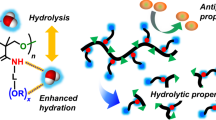Abstract
This paper is concerned with the activation of platelets by polymers, a key-process in the behaviour of prosthetic devices in contact with blood.
Platelets are activated by contact with many different types of polymer surfaces, which must therefore be regarded as thrombogenic. Two procedures for reducing thrombogenicity are discussed: (i) the chemical attachment of inhibitors of platelet aggregation and (ii) gross modification of the nature of the surface, e.g. by making it more hydrophilic. For purposes of (i) the potent prostaglandin analogue BW 245C has been used, while for (ii) grafting of poly(ethylene glycol) (PEG) has been explored. Both methods give greatly reduced platelet adhesion inin vitro tests.
The second part of the paper deals with the properties of adducts of inhibitors of platelet aggregation (BW 245C, dipyridamole) with water-soluble macromolecules [poly(N-vinyl pyrrolidone), PEG, dextran]. Adducts have been synthesized with terminal and side-chain coupling. On adduction the two inhibitors mentioned show opposite types of behaviour: the molar activity of BW 245C is dramatically reduced, but that of dipyridamole is significantly increased. Remarkable synergistic effects have been recorded for BW 245C adducts. These observations are interpreted in terms of differences in stereochemistry in the drug-receptor interactions.
Appropriate chemical techniques for coupling are outlined, attention being drawn to the special uses of haloalkyl- and haloacyl-isocyanates and 2-isocyanatoethyl methacrylate as reagents.
Similar content being viewed by others
References
Bamford C H 1974 InReactivity, mechanism and structure in polymer chemistry (eds) A D Jenkins and A Ledwith (New York: Wiley) p. 52
Bamford C H and Middleton I P 1983Eur. Polym. J. 19 1027; InPlenary and invited lectures Part 2, IUPAC Macro 83, September 5–9, Bucharest, Romania p. 168
Bamford C H, Middleton I P and Al-Lamee K G 1986aPolymer 27 1981
Bamford C H, Middleton I P and Al-Lamee K G 1986bBiochem. Biophys. Acta 886 109
Bamford C H, Middleton I P and Al-Lamee K G 1987aBiochem. Biophys. Acta 924 38
Bamford C H, Middleton I P, Al-Lamee K G, Paprotny J and Carr R (in preparation)
Bamford C H, Middleton I P, Al-Lamee K G and Paprotny J 1987bBr. Polym. J. 19 269
Bamford C H, Middleton I P, Al-Lamee K G, Paprotny J and Satake Y 1987cPolym. J. 19 475
Bamford C H, Middleton I P, Satake Y and Al-Lamee K G 1985 InAdvances in polymer synthesis (eds) B M Culbertson and J E McGrath (New York: Plenum) p. 291
Bamford C H, Middleton I P, Satake Y and Al-Lamee K G 1986c InBlood compatible materials and their testing (Dordrecht: Martinus Nijhoff) p. 159
Bots J G F, van der Does L and Bantjes A 1986Biomaterials 7 393
Brockwell M A, Caldwell A G and Whittaker N 1981J. Chem. Soc., Perkin Trans. 1 706
Chesterman C N, Owe-Young R, MacPherson J and Krillis S A 1986Blood 67 1744
Clowes A W, Kirkman T R and Reidy M A 1986Am. J. Pathol. 128 220
Ebert C D, Lee E S and Kim S W 1982J. Biomed. Mater. Res. 16 624
Lyman D, Fazzio F J, Voorhees H, Robinson G and Albo D Jr 1978J. Biomed. Mater. Res. 12 337
Ratner B D, Hoffman A S, Hanson S R, Harkes L A and Whiffen J D 1979J. Polym. Sci., Polym. Symp. 66 363
Sa da Costa V, Brier-Russell D, Salzman E W and Merrill E W 1981J. Coll. Interf. Sci. 80 445
Sung C P and Hu C B 1979J. Biomed. Mater. Res. 13 161
Uziel L, Colombo A, Cacciabue E, Cugno M and Agostoni A 1986 InBlood compatible materials and their testing (Dordrecht: Martinus Nijhoff) p. 29
Whittle B J R, Moncada S, Mullane K and Vane J R 1983Prostaglandins 25 205
Wu K K and Hoak J C 1974Lancet II: 924
Author information
Authors and Affiliations
Rights and permissions
About this article
Cite this article
Bamford, C.H., Middleton, I.P., Al-Lamee, K.G. et al. Modification of polymers for cardiovascular applications—some routes to bioactive hydrophilic polymers. Bull. Mater. Sci. 12, 3–15 (1989). https://doi.org/10.1007/BF02744589
Issue Date:
DOI: https://doi.org/10.1007/BF02744589




